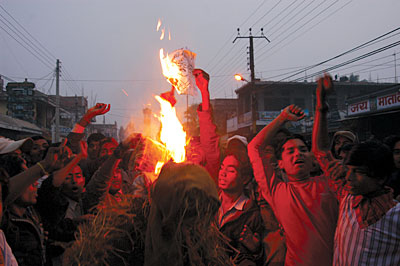 MIN RATNA BAJRACHARYA |
BIRATNAGAR - Over an afternoon chat in his office last week, the Morang CDO mentioned how his district was calm and stable. Same night, the Youth Force chief was shot in Biratnagar.
The UML shut the bajar to protest the assassination attempt. A day earlier, a bus driver in Jhapa was lynched by a wedding party after he requested them not to climb onto the top of the bus. The transport unions of Morang, Sunsari and Jhapa halted public transport to protest the killing of their colleague.
This is relative stability, for the further west you move, the more turbulent things get. Lahan was abuzz with the killing of two guests at a wedding. The same week, a villager was kidnapped by an unknown group. Police negotiated ransom without disclosing their identity, but when they got to the designated spot, the kidnappers ran off. The next day, the abductee was killed.
Janakpur bajar has just about recovered from Arun Singhania's murder. But those active in public life say they are worried about safety, remain extra careful while walking on the streets or talking to strangers, and return home early. A school management committee employee has been shot in the interim. An activist noted that the situation in Mahottari is worse, and there has been a spurt in abductions from villages instead of urban centres. Groups are now targeting families where remittance money is coming in.
All this might lead one to conclude that there is total anarchy in the Tarai. That would not be entirely accurate. State institutions are still present and their penetration, though limited, extends into the interior. There has always been a higher degree of criminality in this belt. Many of the cases stem from histories of personal acrimony, commercial and property disputes, or political or caste rivalry.
But what they do point to is the increasing use of violence to resolve disputes, the easy availability of small arms, the blurred lines between politics and crime, and the emergence of a generation with high aspirations and no opportunities that has learnt how to make a quick buck through loot and extortion.
The state has not failed yet, but the institutional and political relationships that constitute the state are crumbling, and everyone blames the other.
Take what a Janakpur MP told us. "It is the fault of the prashasan, administration. The police get a share of the loot. In fact, they have created many of these criminal groups and use them when convenient." A more objective Siraha journalist concurred, "The Home Ministry in Kathmandu is run on smuggling, drugs and armed group activities in the Tarai. They are all in the loop."
The local administration employs precisely the opposite argument. A senior official in Dhanusha pointed fingers at the local parties. "There are so many outfits; two factions of UML, two Forums, TMDP, NC, Maoist, and Matrika. And all of them exert pressure on the police to release whoever is arrested, claiming he is their cadre." Local officials blame the central Home Ministry for not deploying more personnel or resources. Nepal Police lambasts government intelligence as utterly useless. And the CDO and the SP are sometimes operating at cross purposes.
The only way to prevent further institutional breakdown is to have a stable, strong and inclusive political authority that completes the political transition. Simultaneously, it has to initiate reform of NP, APF and NID; make it more inclusive so it has deeper penetration in society; re-engineer the politician-bureaucrat relationship; deal with longer term issues like political accommodation and putting in place federal structures; and push agrarian and land reform, industrialisation, education and employment generation. All of this will be messy, prolonged and difficult process, but the alternative is a lot worse.
Sadly, the country is saddled with a dysfunctional, corrupt and weak government whose sole purpose is to stay on in power. Madhav Nepal's biggest legacy may well be the further erosion of the state's credibility in the Tarai.
READ ALSO:
Maoist insecurity - FROM ISSUE #494 (19 MARCH 2010 - 25 MARCH 2010)



